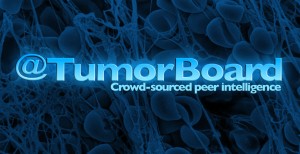Tags
digital health, evidence based medicine, health, innovation, oncology, participatory medicine, tumor board
By Gregg A. Masters, MPH
When the American College of Surgeons Commission on Cancer picked up the accreditation football and in the spirit of the then Joint Commission on Accreditation of Hospitals ‘Joint Commission‘ began the promulgation of specific standards for the accreditation of aspiring ‘cancer programs’, at the center of this consideration was the multidisciplinary cancer conference also known as ‘tumor board.’
Via these standards there were both structural and certain process considerations to meet, but the underlying assumption or zeitgeist of the value proposition – better cancer care – was that ‘multidisciplinary’ engagement of cancer specialists in the diagnosis and treatment of cancer patients would produce superior outcomes.
Then in October of 2012 Keating et al published a study titled: ‘Tumor Boards and the Quality of Cancer Care’. While somewhat dated (interval 2001-2004), and not generally representative of community oncology practices per se (the sample was sourced in the Veteran’s Health System), the conclusions are none-the-less a compelling call to objectively demonstrate long held assumptions of the benefits of tumor board ‘collaboration’.
The background context for the study was noted as follows:
Despite the widespread use of tumor boards, few data on their effects on cancer care exist. We assessed whether the presence of a tumor board, either general or cancer specific, was associated with recommended cancer care, outcomes, or use in the Veterans Affairs (VA) health system.
While Keating et al concluded as follows:
We observed little association of multidisciplinary tumor boards with measures of use, quality, or survival. This may reflect no effect or an effect that varies by structural and functional components and participants’ expertise.
Following publication a series of pieces appeared in the professional press with eye catching headlines such as:
‘Tumor Boards May Not Really Impact Cancer Care‘, and ‘Little association of multidisciplinary tumor boards with effects on cancer care‘, but the title that grabbed our attention was an opinion piece in response to the Keating study offered by Douglas W. Blayney, MD, Stanford Cancer Institute, Stanford School of Medicine, titled: ‘Tumor Boards (team Huddles) Aren’t Enough to Reach the Goal‘.
Blayney details his reasoning and observation while cautioning against the potential ‘knee jerk’ over reaction by some to the Keating conclusions and ‘market aftermath’ as follows:
Tumor boards have too long a history for them to be easily
abandoned. Much like the “hurry-up” offense changed the conduct of huddles in football, tumor boards should also adapt to the changing times and technology. In the system studied by Keating et al. (1), there are only huddles and no feedback loop. Their measurement work provides a reason to change tumor board conduct.
On ‘This Week in Oncology‘, May 22nd, 2013 at 2PM Pacific/5PM Eastern Dr. Blayney is our very special guest. We’ll dive deeper into his thought process, rationale and recommendations to tweak the tumor board formula via technology and other process adds, to perhaps better align this important multi-disciplinary experience with improved patient outcomes.






